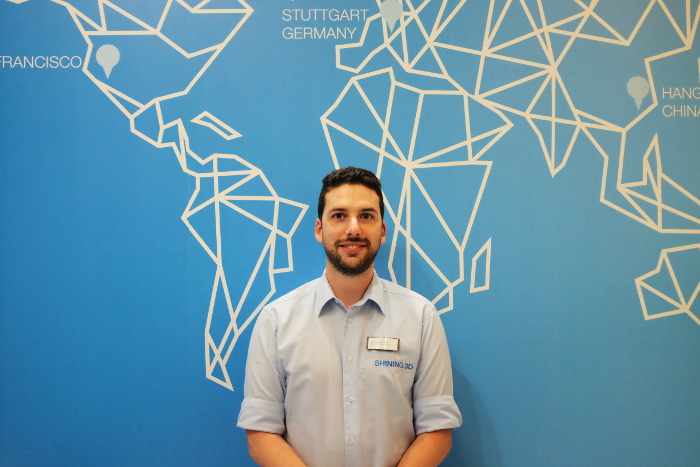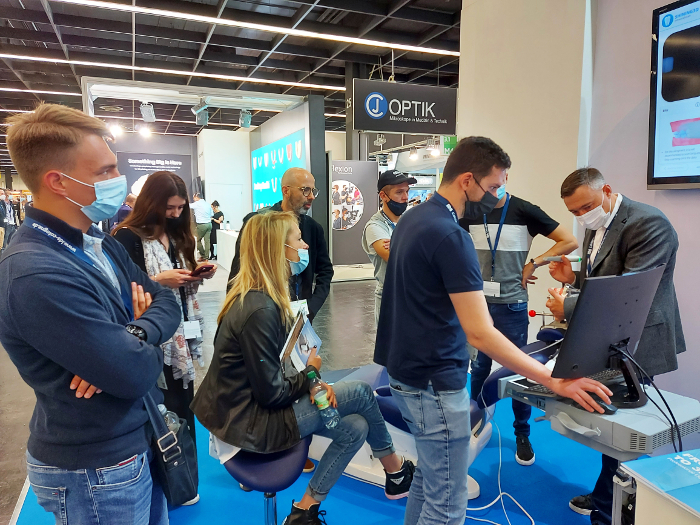Intra-oral scanners and 3D printers were two of the biggest topics in the halls of this year’s International Dental Show (IDS) in Cologne in Germany in September. At the show, Dental Tribune International visited the booth of SHINING 3D and spoke with Riccardo Molinelli, regional sales manager for the Europe, Middle East and Africa region, about the company and its new Aoralscan intra-oral scanner and AccuFab-L4D large-format dental 3D printer.
Mr Molinelli, could you please tell us about SHINING 3D?
The company was founded in 2004, and for the last 17 years, it has been focused entirely on the development of 3D-digitising and 3D-printing solutions. We are fully focused on the development of scanners and 3D printers for multiple applications. Indeed, dentistry is only one of the business areas served by the company. We also cover industrial and metrological applications and the 3D-digitising of most common objects. These different business units have application for both scanning and 3D printing.

What is the company offering to dental professionals?
We began developing dental scanners around 2012. We are proud to look back to our very first product, which was a desktop scanner for a dental laboratory, and to compare it with what we see around us here at our IDS booth—a full suite of digital solutions for both dental clinics and dental laboratories. Over the years, we have developed more powerful and better-performing desktop scanners, and we have also developed and launched 3D printers and our intra-oral scanning solution.
The company is exhibiting two new products at IDS: Aoralscan 3 and AccuFab-L4D. What should dental professionals know about these new products?
The first thing that I would say is that we can think about these two products either as stand-alone solutions or as a bundled solution that has been developed specifically for a dental clinic. That does not mean that the L4D printer cannot be used in the laboratory. However, from our point of view, this is an ideal 3D printer for use with the intra-oral scanner in order to cover the needs of dentists. There is a series of different reasons behind this. Firstly, the footprint and design of the unit are ideal for clinics, where space is often limited. Furthermore, all of the possible applications that the printer is equipped for—such as printing crowns, orthodontic models and surgical guides—make it an ideal choice for dental clinics. One additional point I would like to stress is that the printer is an open system. This means that, if the dentist is already familiar with third-party materials, we can integrate those third-party materials into our 3D printer without any limitations.
We just saw a demonstration of the Aoralscan intra-oral scanner. How have dental professionals at IDS reacted to it?
Aoralscan is something that we are very proud of. We have worked on this technology for several years, and what we see being demonstrated here at the booth is the result of our constant investment in research and development and in product improvements. This intra-oral scanner comes with a lot of nuances, both from the hardware and software point of view. The previous generation remains an excellent product, but what I can say about the new scanner at the end of this four-day exhibition is that we have received extremely positive feedback from users from all around the world. We have had excellent feedback with regard to the scanning speed, the precision of the data collected, and the multiple applications and options that can be covered by this brand-new device.
“Our philosophy is to provide products that have the longest possible lifetime—not only from the hardware point of view but also in terms of software”
The company has a global network. What are the advantages of this for dental clinics and laboratories?
We have a sales network that covers five continents and three offices. Our headquarters is located in Hangzhou in China, and we have offices in San Francisco in the US, and in Stuttgart in Germany. The greatest benefit of this structure is that, for technical support and sales support, our customers know that there will always be somebody to assist them. What we do on a daily basis is to support dentists and laboratories all over the world. Fortunately, we can also rely on the wonderful support of our dealers around the world. It is a matter of cooperation, and we are very satisfied with the partnerships that we have and the advantages that they bring for our customers.

Does SHINING 3D cater to smaller dental clinics and laboratories as well as to larger businesses?
Yes. Our service meets all of the needs that arise in the dental clinic and laboratory. For example, there may be a very simple restoration that is required—like a single crown restoration—and, thanks to the process of scanning, CAD and 3D printing, this can be done directly in even the smallest of clinical settings. In contrast, thanks to the interconnection between our devices and the software that we have, SHINING 3D’s solutions can cover even the most complicated type of restoration for every type of patient, including restorations that require multiple steps to be completed between clinics and laboratories.
What more can you tell us about the software?
We work in partnership with exocad—the world leader in CAD—and through this partnership, we have direct integration of exocad software. Both our scanners and printers directly communicate with exocad in the most efficient way, and we also have integration with other software providers on the market. What I can say is that we offer a fully open system. Our devices, scanners and printers are an open system that can communicate and interact with any other open system. Our philosophy is to provide products that have the longest possible lifetime—not only from the hardware point of view but also in terms of software. That is why we provide software licences that do not have annual fees and do not have fees involved for updates.
What should dental professionals watch out for in order to ensure that these digital tools remain an asset in their daily practice?
Digital dentistry represents an improvement and an advantage for dentists and dental technicians only if it is integrated into a complete system—only if the digital tools assist them from the beginning to the end of the treatment or task. Otherwise, it is possible that the technology can represent an obstacle. If one company provides all the steps of the digital solution, and if that company has expertise in the different segments of this digital workflow—scanning, CAD and 3D printing—then this represents the greatest advantage for clinicians. There is a simple reason behind this: the learning necessary for the individual steps will be drastically reduced, owing to the fact that the customer will always be able to rely on the most direct support. This is what SHINING 3D represents: a digital solution that is integrated, complete, constantly up to date, and accessible and affordable for all dentists and dental technicians.
 ENG
ENG








